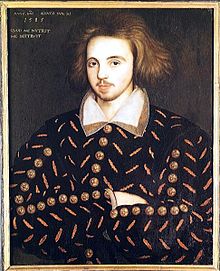Di Lorenzo Mancini-3^D-
Christopher Marlowe was born in Canterbury in 1564 from John Marlowe, shoemaker and tanner, a wealthy man, and by Katherine Arthur, daughter of a minister of worship, and was the second son of nine children. After attending King’s School in Canterbury, he won a scholarship to enroll in Corpus Christi College in Cambridge in 1580.
His school career was highly respected: he received a rich preparation in theology, literature and classical rhetoric, knowledges that will all contribute to the formation of his poetic language. He probably joined the secret services in Canterbury. The necessity of this special department was motivated that under the reign of Elizabeth I, catholics repeatedly plotted against the queen, probably inspired by the catholic Mary Stuart, sovereign of Scotland. The second half of the sixteenth century was the era of religious persecutions, those against free thinkers and against profane Italian and French literatures, and it was also a period of debates on the great existential questions, such as man’s relationship with God or on interpretation of the Scriptures, but especially they were the years of the controversy between the followers of the Aristotelian system and the Neo-Platonism. The influence of Protestantism and the one of the Italian Renaissance made itself felt almost simultaneously in England, giving rise to an era full of conflicts which the darker aspects of religion managed to creep into a landscape characterized by the confidence of the Renaissance in man. In the meantime, Marlowe continued his studies on Italian authors, such as Giordano Bruno and Machiavelli. In 1587 he moved to London, where he rapidly established himself as the most important playwright of the period. Modern experts say that he would have written some tragedies with Shakespeare such as Henry IV and Titus Andronicus during his period in the circle of Sir Raleigh.
But the most important thing that I want to discuss is, what is therefore coming from Marlowe’s work?
Marlowe, unlike Shakespeare, produced a type of theatre that was scandalous to the austere Elizabethan audience. In the character of the “Jew of Malta”, the scandal was twofold because not only a Jew was brought onto the scene, a figure often detested by the Renaissance public, but also because the prologue of the work was entrusted to Machiavelli, an author hated then in England, but adored by Marlowe. After with the creations of his great classics, Marlowe was decidedly unmatched. From Tamburlaine the Great, who represented the insatiable desire to possess the world, to the Jew of Malta, synonymous of desire for wealth and freedom , until Doctor Faustus, stronger than any other symbol of the desire of know, in his short life Marlowe explored the whole phenomenology of power and the desire for omnipotence. Critically retracing the work, we can identified two paths: the first goes from Tamburlaine to Edward II and the second from the Jewish Barabbas to Doctor Faust. They are literary ways characterized by the correct use of the sublime, dosed in all its shades, from grandiose to grotesque. There is always, in fact, a double register in Marlowe’s speech: affirmation and denial build an ambiguity that was part of the metaphysical debate of his time on the eternal struggle between life and death, on the clash between the good and evil and the perennial challenge and rebellion against the human fate of mortality. With Christopher Marlowe the texts took on provocative and cruel tones against the hypocrisy of the world in which he found himself living. Many define him as the cursed voice of the Elizabethan theatre.







